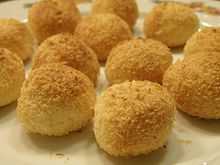Cocadas
| Cocadas | |
|---|---|
| Confectionary or Candy | |
 | |
| Place of origin: | |
| Mexico | |
| Serving temperature: | |
| Room temperature | |
| Main ingredient(s): | |
| Eggs, shredded coconut, food coloring, Sugar, Brown Sugar, coconut milk, condensed milk, Fruit Syrup | |
| Recipes at Wikibooks: | |
|
| |
| Media at Wikimedia Commons: | |
|
|
Cocadas are a traditional coconut candy or confectionery found in many parts of Latin America. They are particularly popular in Mexico, Brazil, Colombia, Venezuela and Chile. They are oven baked but are served at room temperature to provide their chewy and soft texture. Made with eggs and shredded coconut, cocadas come in a variety of colors due to the modern use of food coloring,[1] however the traditional variations are golden brown. They are often garnished with almonds, either whole or chopped.[2] There are hundreds of cocadas recipes, from the typical hard, very sweet balls to cocadas that are almost the creamy texture of flan.[1] Other fruit, often dried, can be added to the cocadas to create variety, which will also lend to a wide specturm of cocada colors.[3] Cocadas are mentioned as early as 1878 in Peru.[4]

By Country

Mexico and Colombia
In Colombia and Mexico, cocadas are sold not only as artisan candies from shops, but commonly on the streets, out of baskets, and particularly on the beaches, by men or women who carry them on large aluminum trays.[5]
Brazil
In Brazil, cocadas are a traditional confectionery originating from the north east side of the country. One variation of cocada in Brazil is the "black cocada" made with brown sugar and slightly burnt coconut. In Brazil, "rei da cocada" (cocada king) is used to refer to an arrogant person who thinks too highly of himself.
Venezuela
In Venezuela, cocadas is a drink blended with coconut and the confectionery or candy form is called "conserva de coco".
See also
Notes
- ↑ 1.0 1.1 Mounts, Deborah "Cocada Dessert Recipe" BellaOnline, accessed 5 March 2010
- ↑ "Cocada Dulce" in Spanish, accessed 5 March 2010
- ↑ Reichel-Dolmatoff, Gerardo and Reichel-Dolmatoff, Alicia (1961) The people of Aritama: the cultural personality of a Colombian mestizo village University of Chicago Press, Chicago, page 63, OCLC 1488921
- ↑ Raimondi, A. (1878) "Zur physikalischen Geographie von Peru - II" Globus 36: pp. 173-175 page 174, in German
- ↑ McCausland-Gallo, Patricia (2004) "Cocades Costeñas" Secrets of Colombian Cooking Hippocrene Books, New York, page 177, ISBN 0-7818-1025-6
External links
- Mexico Cooks!, photograph of cocadas.